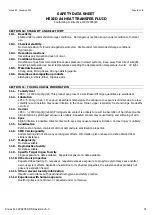
Issue 6.3, January 2020
Page
3
of
4
SAFETY DATA SHEET
HEXID A4 HEAT TRANSFER FLUID
Conforming to Directive 1907/2006/EC
SECTION 10: STABILITY AND REACTIVITY
10.1. Reactivity
Stable under recommended storage conditions. No dangerous reaction known under conditions of normal
use.
10.2. Chemical stability
No decomposition if stored and applied as directed. Stable under recommended storage conditions.
Hygroscopic.
10.3. Hazardous reactions
Hazardous polymerisation does not occur.
10.4. Conditions to avoid
Generation of gas from decomposition causes pressure in closed systems. Keep away from direct sunlight.
Avoid high temperatures. Avoid temperatures exceeding the decomposition temperature. Avoid UV light.
10.5. Materials to avoid
Strong acids, Strong bases, Strong oxidizing agents.
10.6. Hazardous decomposition products
Aldehydes, Alcohols, Ether, Organic acids.
SECTION 11: TOXICOLOGICAL INFORMATION
11.1. Toxicity Oral
LD50 : > 20000 mg/kg (rat) This product can present a small hazard if large quantities are swallowed.
11.2. Inhalation
LC50 : 6.15 mg/l (rat; 4 h; vapour) At ambient temperature the exposure to vapours is minimal due to a low
volatility rate. Inhalation may cause irritation to the nose, throat, upper respiratory tract and lungs. No deaths
occurred
11.3. Dermal
LD50 : > 20000 mg/kg (rabbit) Prolonged skin contact is unlikely to result in absorption of harmful amounts.
Skin irritation by prolonged exposure is unlikely. Repeated contact may cause flaking and softening of skin.
11.4. Eyes
Slight irritation is possible. Direct contact with eyes may cause temporary irritation. Corneal injury is unlikely.
11.5. Sensitisation
Patch test on human volunteers did not demonstrate sensitisation properties.
11.6. CMR Carcinogenicity
Animal testing did not show any carcinogenic effects. Information given is based on data obtained from
similar substances.
11.7. Mutagenicity
No data available.
11.8. Reproductive toxicity
No data available.
11.9. Specific Target Organ Toxicity
Single exposure no data available. Repeated exposure no data available.
11.10. Other toxic properties
Repeated dose toxicity. In rare cases, repeated excessive exposure to propylene glycol may cause central
nervous system effects. Aspiration hazard Due to its physical properties, the substance does probably not
pose any aspiration hazard.
11.11. Other relevant toxicity information
Handle in accordance with good industrial hygiene and safety practice.
11.12. Experience with human exposure
Health injuries are not known or expected under normal use.
Annex R-3 200203 SDS Hexid A4 v6.3
31


































